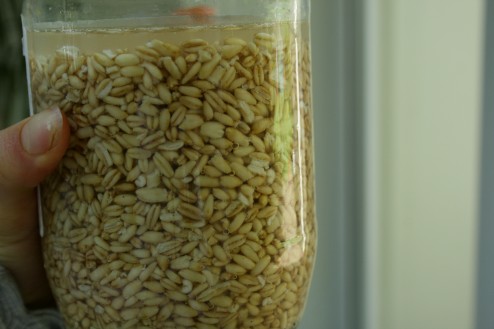Antioxidant-Rich Oats Could Be the Next Anti-Inflammatory Superfood
For several years, I’ve been studying the potential anti-inflammatory benefits of high-antioxidant oats. Based on the results, I believe that the potential is there for specialized oat products that provide significant health benefits for consumers.
Contents
Studying the Health Benefits of Oats
The potential health benefits and anti-inflammatory properties of oats has been a focus of my research for several years (read my previous blog for more), with help from the USDA Cereal Crops Research Unit and researcher David Peterson.
I’ve always had a focus on antioxidants in food, starting out with fruits and vegetables. After being approached by David, who was interested in antioxidants in grains, we began to examine the anti-inflammatory properties of oats. Oats and oatmeal have always been known as a healthy grain, packed with nutrients, fiber and protein, but we now have a body of evidence that suggests it can work as an anti-inflammatory agent in the body. As we’ve continued to conduct more rigorous research on oat antioxidants, I’m increasingly certain that the potential is there to create new types of oats and oat-based food products that could be highly beneficial.
Gathering Evidence on Oat Antioxidants
We initially began our tests on rats, feeding them a diet rich in avenanthramides (AVEs), the compound in oats that we believe has anti-inflammatory properties. Our initial lab results, which contrasted a group of rats fed a high-AVE diet with a control group fed food made from corn flour, were encouraging. The rats who ate the high-AVE diet showed great antioxidant effects and a resistance to exercise-induced cell damage.
From there, we expanded our research to human subjects. Through a company in Canada, we obtained variety of oats made high in avenanthramides through hybrid selection, and generally used to create oat extracts for cosmetic products. Both young and older women (60-75 years old) who took part in the study performed long sessions of downhill running – an activity known to be particularly prone to causing muscle inflammation. The participants in the test group were fed two cookies of about 30 grams and 125 calories, each made from the high-AVE oats. The control group ate cookies that were identical in every other respect – ingredients, calories, etc. – but contained few AVEs. At the end of the 8-week study, we saw a significant decrease in inflammatory blood markers in both the young and older women who consumed the oats.
Building a Stronger Case
Though both our initial studies were encouraging, we wanted to make sure that we answered two questions about oat antioxidants:
- Could we be sure that it was the AVEs in oats causing the anti-inflammatory effect and not some other substance?
- By what process do AVEs inhibit inflammation?
To answer the first question, we studied what scientists call “bioavailability.” In layman’s terms, this means that we can detect the presence of the avenanthramides from oats in a test subject’s organs, tissue and/or blood plasma. If we don’t find the compound, it’s likely that the effect is caused not by the compound we’re studying, but by some other substance or byproducts of the metabolization process.
We’ve already published a paper confirming that AVEs are bioavailable in rats, and I’m happy to report that our study on human subjects confirmed that AVEs are also bioavailable to humans. We are submitting our findings in a manuscript to the Journal of Nutrition.
The second question is a bit more complex, and requires us to learn the real molecular mechanism by which AVEs inhibit inflammation. By studying the effects of AVEs on cultured muscle cells, I believe we’ve come up with an answer – one that has been reported in an abstract accepted by the American College of Sports Medicine. Basically, we believe that AVEs bind to the DNA of an enyzme in the body that activates the inflammatory pathway NF Kappa B. Similar to the way that beta-blocking drugs block adrenaline receptors, AVEs help slow the activation of inflammation in the body.
What Does the Future Hold for Anti-Inflammatory Oat Antioxidants?
Our years of study have given me confidence that high-AVE oats can have positive anti-inflammatory health benefits. Now it’s going to be up to the food and agriculture industries to bring these benefits to the general public.
Right now, the oats you buy at the grocery story are not nearly as high in AVEs as the ones used in our studies. Common, store-bought oats contain between 20 and 80 PPM (parts per million) of avenanthramides, depending largely on the crop variety. The special hybrid we made our cookies out of had an AVE content up to 200 PPM.
It’s my hope that large agriculture and food companies will see the tremendous potential market for oat-based foods that help decrease inflammation. I’ve already heard that a few companies are considering launching sports drinks with high-AVE oat additives. Some are even packing AVEs in a capsule as a drug. In the meantime, I do encourage you to make oats a part of your diet. While we have not yet conducted long-term studies of supplementing normal oats, I believe that oats that have lower concentrations of avenanthramides may indeed provide benefits over months or years of use. Even better, you’ll be getting all the other nutritious benefits that oats provide.
https://cehdvision2020.umn.edu/blog/antioxidant-rich-oats/
New “tolokno” to increase avenanthramides
- anaerobically steeped in tap water at 32 C for 18 hours
- air dried in a seed dryer for about four hours
- surface sterilized as above only using 0.25% aqueous sodium hypochlorite solution at room temperature for 1 hour
- ‘false malted” at temperature 37 C in the dark for 96 hours, using the controlled temperature convection oven






